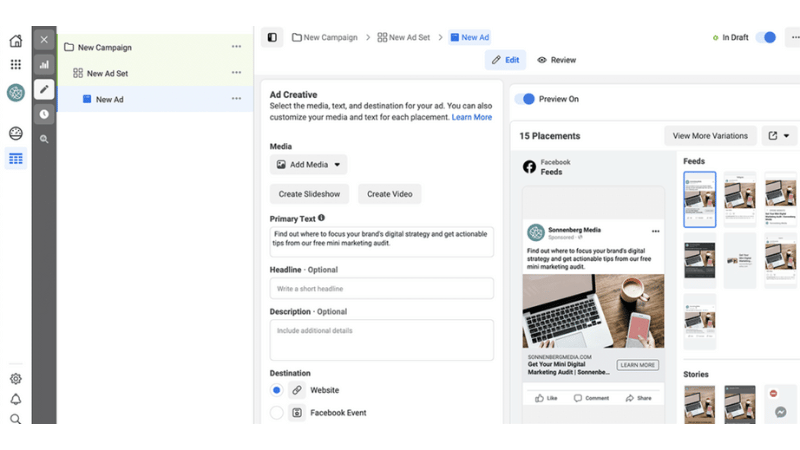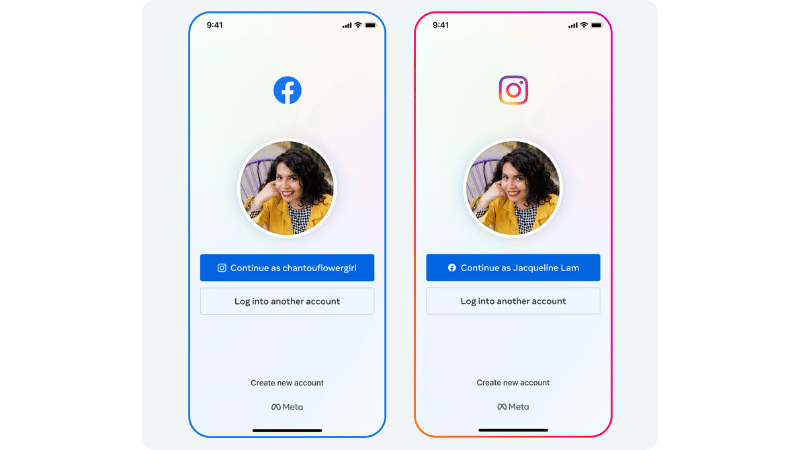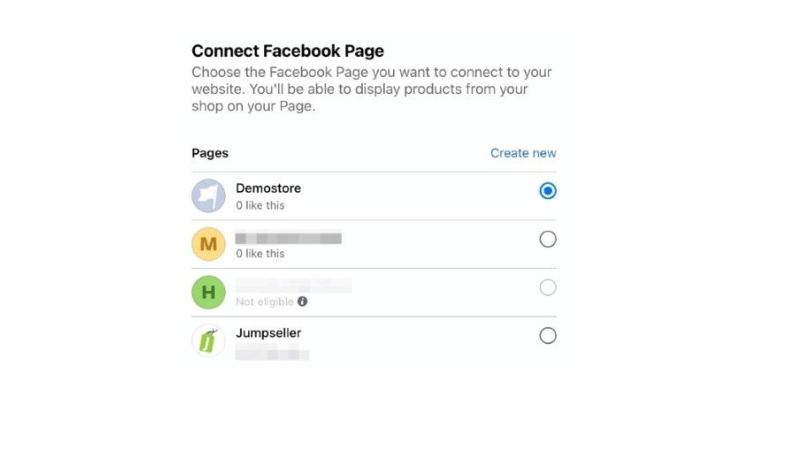Many businesses choose to run Facebook advertising due to its easy implementation, low cost, and ability to reach many target customers. However, simply running Facebook Ads does not guarantee the best results, especially for beginners learning about advertising. Understanding this, today the experts at Optimal Agency will share with you how to set up effective Facebook ads. Check it out now!
How to set up effective Facebook ads in 2025
To run effective Facebook ads, new advertisers need to meticulously prepare some prerequisites. This is the mandatory foundation before we can launch and optimize any campaign on Facebook or Instagram.

Step 1: Create Facebook and Instagram accounts
The first and most important thing is that you must have a real personal Facebook account. Do not use a fake account or false name, as Meta may lock or restrict your ad account. Remember that a personal Facebook account is different from a Facebook Page.

- Personal account: bears your real name.
- Facebook Page: created under your personal account, bearing the name of the business or brand.
If you plan to run ads on both Instagram adsFacebook, create an Instagram account and connect the two platforms. However, if you only advertise on Facebook, a Facebook Page is sufficient.
Step 2: Connect the Facebook page with the Facebook account
This step helps your ad display simultaneously on both platforms.

- Go to your Facebook Page → select See More → Pages → select the Page you need to connect.
- Go to Settings → scroll down to Linked Account → select Instagram → Connect Account → log in to your Instagram account.
When you see the message “Connected to Instagram,” the two platforms have been successfully connected.
Step 3: Access Meta Business Suite
Go to business.facebook.com to access Meta Business Suite—the operations center for all your advertising activities.
Here, you can:
- Manage your Page and ad accounts.
- Monitor campaign performance.
- Schedule posts or report results.
In Settings → Business Settings, you will find important sections like Users, Accounts, and Data Sources—where we will establish the ad structure.
Step 4: Create an Ad Account
Go to Accounts → Ad Accounts → Add → Create a new ad account.
Here, you need to select the appropriate time zone and currency. For example:
- If you are in Vietnam, select the Asia/Ho_Chi_Minh time zone and the VND currency.
- If you are in Nigeria, you can use Naira (₦) and the Africa/Lagos time zone.
In many countries, Facebook supports two types of accounts:
- Prepaid – you manually deposit money before the ad runs.
- Postpaid – Meta automatically deducts money from the payment card (not available in some countries).
Once completed, click Agree to Terms → Create Ad Account → Done.
Step 5: Fund the Ad Account
Go to All Tools → Billing and Payments → Add Payment Method.
Here, you can choose the funding method: Meta provides a Virtual Account Number for you to make a bank transfer. Once completed, the balance will automatically update.
We recommend not adding a payment card, as Meta will automatically deduct money (postpaid). Instead, only use the Add Funds option for manual deposits.
Step 6: Create and install the Facebook Pixel
The Pixel is the tool that helps Facebook track user behavior on your website—for example, who clicked the ad, visited the product page, or filled out a contact form. Proceed as follows:
- Go to Meta Business Suite → Settings → Data Sources → Datasets & Pixels → Add → Create a new dataset.
- Name it, for example: Optimal Agency Pixel.
If your website uses WordPress:
- Install the MetaPixel for WordPress plugin → Activate → Settings → Get Started.
- Log in to Facebook → select your Business Portfolio, Facebook Page, Ad Account, and the Pixel you just created.
- Turn on Automatic Advanced Matching → Continue → Done.
When finished, the Pixel is successfully connected and starts recording user data.
Step 7: Set up events
Go to Event Manager → Set up MetaPixel → Use Partner Integration → WordPress → Next.
Add your website and select the actions to track:
- View Content – track people viewing the homepage.
- Lead – track people filling out a contact form.
- Initiate Checkout – track people clicking the “Order Now” button.
Each of these actions is recorded as an event to measure campaign effectiveness.
Step 8: Finalize and start running ads
After setting up all the steps above, return to Meta Business Suite to create your first campaign.
Thanks to the installation of the Pixel and Event Tracking, you can accurately analyze customer behavior, determine which ads are most effective, and optimize your budget more easily.
Effective campaign scaling tips from Facebook advertising experts
When it comes to scaling Facebook Ads campaigns, many advertisers often think that simply increasing the budget will lead to increased revenue. However, industry experts find that to scale a campaign while maintaining stable performance, you need a strategy based on concrete data, deep analysis, and continuous optimization. Below is the practical process that Optimal Agency has applied across hundreds of ad accounts, helping clients achieve hundreds of thousands of dollars in revenue in just a few weeks.
With over 11 years of experience in providing advertising resources and ad account rentals, Optimal Agency is proud to be an official partner certified with the Facebook badge. Throughout our operation, we have built a robust system of accounts, diverse in time zone, currency unit, and country, helping to flexibly meet the needs of all advertisers.
We are committed to providing clients with high-quality Facebook Ads accounts with superior trust scores, 100% clean, no debt, and no policy violations. Notably, our accounts have been tested across a series of ad campaigns in challenging verticals like cosmetics, tobacco, and casino, ensuring stable and optimized performance for all large-scale campaigns.
Detailed results analysis
This is the core part that every Facebook advertiser should perform, a process that requires meticulousness and a careful analysis of every number in Facebook Ads Manager. First, access Breakdown → Audience Segments. Here, you will see three main audience groups:
- New (new customers)
- Engaged (people who have interacted)
- Existing (past customers)
In a real-world example, we executed for a client in the fashion industry, the majority of the spend was allocated to the New Audience, which is an excellent signal. Many advertisers tend to play it “safe” by increasing spend on the Engaged or Existing groups, but we do the opposite.
Determine the actual profit threshold
Before expanding spending, we always conduct a detailed profit analysis to know which campaigns are truly profitable. For example, in an e-commerce account:
- New Customers: Average ROAS 1.67
- Engaged: Average ROAS 3.0
- Existing: Average ROAS 3.0
We know that a lower ROAS in the new customer group is perfectly normal because the initial Cost Per Conversion is always higher.
Therefore, our team set the baseline profit threshold at 1.7 for this group, and clearly explained to the client: “When scaling the budget, the average ROAS may slightly decrease, but the total profit and revenue will sharply increase.”
After 30 days, the ROAS for the New group increased to 1.9, while the other two groups maintained around 3.0. As a result, the account’s total ROAS remained stable, and the campaign scaled successfully.
Spend scaling strategy
Instead of increasing by 10% daily like the “old rule,” we scale the budget flexibly based on real-world data. A specific example:

- Week 1: $16,000
- Week 2: $29,000 (60% increase) → ROAS remained the same
- Week 3: $37,000 → ROAS slightly decreased to 2.12
- Week 4: $91,000 (3x spending) → ROAS only decreased by 0.6
Final Result: revenue increased 3 times, profit still increased, despite a slight decrease in ROAS. This proves that increasing spending does not necessarily reduce effectiveness, provided you understand how to allocate and track the correct metrics.
Analysis by attribution windows
One of the factors many advertisers often overlook is Attribution Windows, especially since Meta recently expanded this option. Go to Columns → Compare Attribution Settings, and you will see the modes:
- 1-day Click
- 7-day Click
- 1-day View
- Incremental Attribution
The Incremental Attribution feature (launched April 2025) helps measure actual incremental conversions, allowing you to know if the ad truly brought in new customers or was just re-engagement.
Example: if the View-through conversion rate is >30%, it means you are reaching too many people who already know the brand.
In a client account in the food industry, we saw that only 385 out of 2,434 conversions came from views (≈16%), proving the campaign was truly reaching new customers.
Ad level analysis
We delve into the performance of each ad to identify the element that brings the highest revenue.
The metrics to track include:
- Cost per Purchase
- ROAS by group (New, Engaged, Existing)
- Incremental Attribution
An ad may perform well with past customers, but is not suitable for scaling if the ROAS for the New group is low.
Example: Ad A has a New ROAS of 1.2, but engaged ROAS up to 3.5 → this is only an ad for “nurturing” past customers.
Conversely, the ideal ad to scale must have New ROAS ≥ the campaign’s average ROAS.
In an account we manage, two ads stood out:
- Ad #1: $34/order, New ROAS = 1.72, 7-day ROAS = 2.0
- Ad #2: $37/order, New ROAS = 1.94
After we created variant versions (changing the hook, CTA, headline, keeping the layout), the breakthrough results were clear:
- Ad #1 (new version): $81,000 spent
- Ad #2 (new version): $34,000 spent
Both achieved New ROAS above 2.0, helping to scale the campaign sustainably and achieve stable profit growth.
In the context of the constantly changing Meta platform, updating trends and testing new strategies are key factors for advertisers to maintain a competitive advantage. Remember that a successful campaign lies not only in the budget but in the understanding of user behavior and the ability to continuously optimize data. If you persistently monitor, analyze, and improve every step, ad effectiveness will surely grow sustainably over time.
Frequently Asked Questions
Regardless of whether a business is small or large, Facebook Ads delivers high effectiveness in reaching target customers, promoting products and services, and increasing sales. Facebook advertising is the top choice for small businesses. This is because they do not need a huge budget to run ads to reach their target customers. The method of implementing campaigns is quite simple, and businesses can optimize ads effectively.
Depending on the business objective, the business will choose the appropriate ad campaign objective. If your business aims to increase website traffic, you can choose to run a traffic campaign. If you want your business, products, or services to be known by more people, you should run a campaign to increase awareness level, etc.